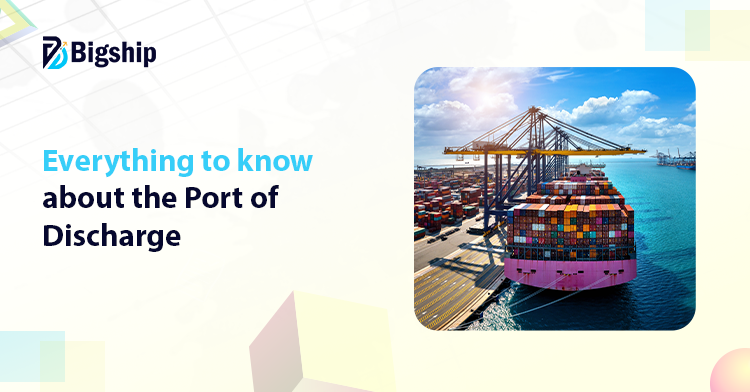Every shipment reaches a point where the journey ends and the next step begins, that place is the port of discharge. It’s where your cargo is unloaded, checked, and prepared for delivery. This stage holds great importance because even a small delay or missing document can keep your goods stuck at the port. The process may seem complex, but once you know how it works, everything becomes easier to manage.

In this blog, we’ll understand everything about the port of discharge, its role in shipping, required documents, and why it matters in your supply chain.
What is a Port of Discharge?
The port of discharge means the place where your goods are unloaded from the ship after traveling by sea or from the plane after traveling by air. It’s like the final stop before your cargo moves inland. Once the ship or plane reaches the port, the sea or air part of the journey ends, and the goods are prepared for customs and delivery.
Now, don’t confuse it with the Port of Loading (POL). That’s where your goods start their trip, the place they are first loaded onto the ship or the plane. The port of discharge is where the unloading happens. Simple difference, one is the start, the other is the finish.
This port also appears in key trade papers such as the Bill of Lading, Import Manifest, and other customs documents. These details help authorities track the cargo, check import duties, and confirm where the goods will be received.
For instance, if a shipment leaves Hongkong and reaches Chennai, then Chennai becomes the port of discharge. It’s where the cargo leaves the vessel and enters India’s import process.
Importance of Port of Discharge in supply chain and logistics
The port of discharge plays a vital role in a cargo’s journey. It’s more than just unloading the goods, as it directly affects how quickly, smoothly, and cost-effectively your entire supply chain operates.
Affects Delivery Time: A busy or slow port can delay unloading, causing missed deadlines and late deliveries.
Influences Shipping Costs: Extra waiting time can bring demurrage or detention fees that could hurt your profit.
Controls Inventory Flow: Late arrivals at the port can disturb stock planning and customer orders.
Decides Handling Efficiency: Ports with better facilities and management speed up cargo movement in the destination country.
Determines Overall Logistics Performance: A well-functioning port of discharge keeps your supply chain steady and reliable.
What documents are Required at the Port of Discharge?
Upon the arrival of your cargo at the port of discharge, the next step is paperwork. The documents you need at the port are mentioned below.
Bill of Lading: It’s the main proof that the goods belong to you and confirms shipment details.
Packing List: It shows what’s inside each package, thus helping customs officers check everything easily.
Commercial Invoice: It lists the value, quantity, and type of goods for duty and tax purposes.
Terminal Handling Receipt: This document confirms that the port has received your containers for processing.
Certificate of Origin: Proves where your goods were made, which affects import duties.
Export Customs Clearance Declaration: It verifies that the goods were cleared for export at the origin port.
Warehouse Receipt: Acknowledges that your cargo has been stored in a warehouse temporarily.
Container Release Order: It grants permission to collect the container after customs clearance.
Gate Pass: This is the final pass that lets your goods leave the port premises.
Factors to consider when selecting a Port of Discharge
Choosing the right port of discharge can make a big difference in how quickly and safely your goods reach their destination. Every port works differently, and a smart choice can save both time and money. Here are some key factors you should look at before finalizing one.
- Pick a port close to where the goods will be delivered. A nearby port cuts inland transport costs and helps your shipment reach faster.
- Consider the port infrastructure, such as good cranes, storage yards, and transport connections. A port with modern facilities handles cargo faster and with fewer issues.
- Some ports stay crowded, which can slow down unloading. Thus, checking how busy a port usually gets helps you plan better and avoid hold-ups.
- Your cargo’s safety matters, so choose ports known for strong security systems and lower risks of theft or damage.
Common challenges faced at the Port of Discharge
The port of discharge is where most shipment delays and extra costs usually arise. Here are some common problems you might face when your cargo reaches this stage.
Unskilled Handling Staff: If workers mishandle goods or use improper equipment, it can cause damage, especially to fragile or high-value cargo.
Heavy Port Traffic: When too many vessels arrive at once, unloading slows down. Congestion means longer waiting hours and higher storage or demurrage fees.
Weak Infrastructure: Ports with limited cranes, poor storage areas, or broken equipment struggle to manage heavy cargo loads. This causes delays and even spoilage in perishable goods.
Incomplete Paperwork: Missing or incorrect documents often lead to customs holds. Even a small mistake can stop your goods from leaving the port on time.
Weather Delays: Sudden storms or rough sea conditions can disrupt port schedules and slow down unloading operations.
How Bigship simplifies Port of Discharge management?
Bigship, one of India’s best courier aggregators, makes port of discharge operations simple and stress-free. You get complete shipment visibility from the moment your cargo leaves the loading port until it reaches its destination. Every movement is tracked in real time, so you always know where your shipment stands.
All important documents are managed by Bigship’s team, reducing manual errors and saving time. It also coordinates directly with ports and carriers to ensure timely clearance and smooth cargo movement. Plus, you receive transparent status updates, thus helping your business stay informed, organized, and confident throughout every stage of the shipping process.
Key Takeaways
- The port of discharge means the place where cargo is unloaded after completing its sea or air journey.
- The port of discharge marks the end of the carrier’s responsibility for ocean or air transport.
- The port of discharge differs from the Port of Loading, where goods are first shipped.
- It plays a major role in determining transit time, cost, and overall supply chain efficiency.
- Proper documentation is essential for customs clearance at the port of discharge.
Conclusion
The port of discharge, besides being a final stop where your shipment’s sea or air journey ends, is a point where the delivery begins. A well-managed port process saves time, prevents delays, and ensures your cargo reaches safely.
Bigship makes this entire process easier with real-time tracking, automated paperwork, and direct coordination with ports. It helps businesses avoid common shipping troubles and stay updated at every step.
So sign up with Bigship and make your port of discharge operation smooth.
FAQs
What does port of discharge mean in shipping?
The port of discharge means the place where your cargo is unloaded from the ship after completing its sea journey.
Why is the port of discharge important?
It marks the end of the sea journey and affects customs clearance, delivery time, and logistics costs.
What documents are needed in the port of discharge?
Some of the documents you need to have are Bill of Lading, Commercial Invoice, Packing List, and Customs Declarations.





